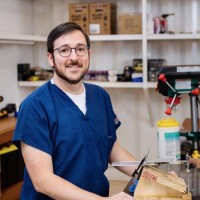In his talk, Dr. Harling shared how virtual reality (VR) has become a vital tool in bridging Burundi’s medical education gap, particularly in surgical anatomy training, where access to cadavers, imaging, and even textbooks is limited or nonexistent.
Medical Education With Almost Nothing
Burundi has just three medical schools for over 14 million people. Hope Africa University, where Dr. Harling teaches, graduated its first class in 2013 and has now trained over 300 doctors. But until recently, none of these graduates had touched a cadaver or used 3D imaging for anatomy. Most learned from black-and-white photocopied syllabi, with only one out of six residents having access to a personal anatomy textbook.
Cadaver dissection was illegal in Burundi until April 2024. Even now, cultural, religious, and logistical barriers continue to prevent widespread anatomical education using traditional methods.
Discovering Medicalholodeck and the Power of VR
Dr. Harling first encountered immersive anatomy through a visiting Fulbright scholar who used a VR headset to teach cardiac defects. That experience sparked a realization: virtual dissection could be a scalable, culturally appropriate, and cost-effective solution for anatomy education in Africa.
He chose Dissection Master by Medicalholodeck—a platform that replicates the depth and fidelity of cadaveric dissection. The experience was so realistic it triggered olfactory recall of formaldehyde from his own training.

Dr. Michael Harling, MD, FCS-ECSA is Assistant Program Director for General Surgery at the Pan-African Academy of Christian Surgeons (PAACS) in Kibuye, Burundi, and Associate Professor at Hope Africa University in Bujumbura. He also holds an appointment as Assistant Professor in the Division of General Surgery at Loma Linda University in California, USA. A U.S.-trained general surgeon, Dr. Harling moved to Burundi in 2020, where he now plays a leading role in surgical education and capacity building in one of the world’s most resource-constrained healthcare settings.
Dr. Harling’s work focuses on equipping the next generation of East African surgeons through innovative, context-appropriate methods. He has pioneered the use of virtual reality (VR) in anatomy education in Burundi, integrating immersive tools like Medicalholodeck into surgical training to compensate for the lack of cadaver access and imaging infrastructure. His efforts reflect a deep commitment to advancing global surgery, medical education, and equitable healthcare access across sub-Saharan Africa.
Implementing VR With Surgical Residents
With no institutional funding, Dr. Harling personally acquired three VR headsets to pilot Medicalholodeck in Burundi. He began using it with surgical residents during lectures on gastric anatomy and tumor surgery—integrating spatial visualization into clinical learning. Residents who had only studied anatomy in 2D paper form now gained a 3D, immersive understanding of vascular, organ, and structural relationships.
Reactions were immediate and powerful. Visiting residents and local trainees alike expressed how transformative it would have been to learn this way from the start. Even nurse anesthetist students and faculty have begun using the platform to better understand airway anatomy and intubation techniques.
Scaling a Vision for East Africa
Dr. Harling’s long-term goal is to expand VR-based anatomy education across Hope Africa University and beyond. His next steps include:
-
Acquiring 12 more VR headsets to equip an entire surgical cohort
-
Recording immersive anatomy lectures in French for continued learning
-
Developing a structured VR/AR curriculum for medical students and residents
-
Launching a formal study to assess comprehension gains from VR-based learning
He also envisions regional adoption across East Africa—positioning VR as a validated, affordable alternative to cadaver-based anatomy training.
Overcoming Infrastructure Hurdles
Despite progress, challenges remain. Internet access in Burundi is among the most expensive in the world. Until recently, Dr. Harling’s team paid over $1,000/month for a 20 Mbps line. Now, with Starlink available, he is hopeful for improved bandwidth to support real-time downloads and remote collaboration.
Another key limitation: a lack of access to de-identified imaging data for case-based learning. With few CT or MRI scans performed in Burundi due to cost, teaching residents how to interpret cross-sectional imaging remains a challenge.
A Call for Support and Collaboration
From teaching with photocopied slides to immersive surgical planning in VR, Dr. Harling’s work represents a bold shift in how medical education can evolve—even in the most constrained environments. With additional support, tools, and shared resources, this approach could redefine how anatomy is taught across sub-Saharan Africa.
For more information, contact info@medicalholodeck.com March 2025